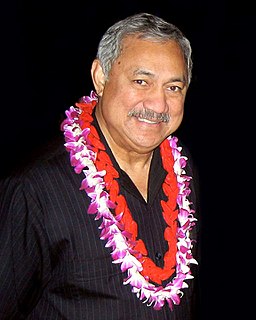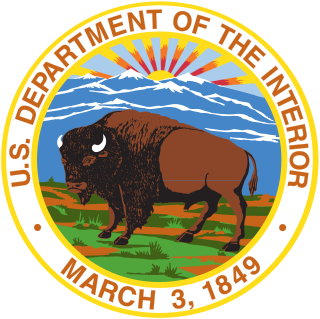
Politics of American Samoa takes place in a framework of a presidential representative democratic dependency, whereby the Governor is the head of government, and of a pluriform multi-party system. American Samoa is an unincorporated and unorganized territory of the United States, administered by the Office of Insular Affairs, U.S. Department of the Interior. Its constitution was ratified 1966 and came into effect 1967. Executive power is discharged by the governor and the lieutenant governor. Legislative power is vested in the two chambers of the legislature. The party system is a based on the United States party system. The judiciary is independent of the executive and the legislature.
A constitutional amendment is a modification of the constitution of a polity, organization or other type of entity. Amendments are often interwoven into the relevant sections of an existing constitution, directly altering the text. Conversely, they can be appended to the constitution as supplemental additions (codicils), thus changing the frame of government without altering the existing text of the document.
In the politics of the United States, the process of initiatives and referendums allow citizens of many U.S. states to place new legislation on a popular ballot, or to place legislation that has recently been passed by a legislature on a ballot for a popular vote. Initiatives and referendums, along with recall elections and popular primary elections, are signature reforms of the Progressive Era; they are written into several state constitutions, particularly in the West.
The current Constitution of the State of Maryland, which was ratified by the people of the state on September 18, 1867, forms the basic law for the U.S. state of Maryland. It replaced the short-lived Maryland Constitution of 1864 and is the fourth constitution under which the state has been governed. It was last amended in 2012.

The Constitution of the State of Connecticut is the basic governing document of the U.S. state of Connecticut. It was approved by referendum on December 14, 1965, and proclaimed by the governor as adopted on December 30. It comprises 14 articles and has been amended 31 times.
State ratifying conventions are one of the two methods established by Article V of the United States Constitution for ratifying proposed constitutional amendments. The only amendment that has been ratified through this method thus far is the 21st Amendment.
The Constitution of the State of New Hampshire is the fundamental law of the State of New Hampshire, with which all statute laws must comply. The constitution became effective June 2, 1784, when it replaced the state's constitution of 1776.
The Ohio Constitution is the basic governing document of the State of Ohio, which in 1803 became the 17th state to join the United States of America. Ohio has had three constitutions since statehood was granted.
The Constitution of the State of New York establishes the structure of the government of the State of New York, and enumerates the basic rights of the citizens of New York. Like most state constitutions in the United States, New York's constitution's provisions tend to be more detailed, and amended more often than its federal counterpart. Because the history of the state constitution differs from the federal constitution, the New York Court of Appeals has seen fit to interpret analogous provisions differently from United States Supreme Court's interpretation of federal provisions.
A process model is, in the context of the republic debate in Australia, a model for the process by which the questions surrounding whether and how Australia should become a republic may be answered. A number of process models have been processed. Proposed process models are a subject of debate within the Republicanism movement. Such debate usually surrounds whether the people should be asked to choose between the current system and a general republican system of government, one specific republican system of government, or multiple alternative republican systems of government.

General elections was held in American Samoa on 4 November 2008, coinciding with the 2008 United States general elections.

The 2008 American Samoa gubernatorial election took place on November 4, 2008, coinciding with the 2008 United States general elections and the American Samoa general election. Because no candidate received more than 50% of the vote, a runoff election between the top two candidates was held on November 18, 2008, which Togiola Tulafono won. All elections in American Samoa are officially non-partisan, but Tulafono and Sunia identify with the Democratic Party.
Tuika Tuika Jr. is an American Samoan accountant and politician. He has worked for various American Samoan government offices for many years.

The United States House of Representatives election in American Samoa, which will contest American Samoa lone At-large congressional district, was held on November 2, 2010. The non-voting delegate to the United States House of Representatives is elected for two-year terms; whoever is elected will serve in the 112th Congress from January 3, 2011 until January 3, 2013.

The American Samoan general election of 2010 took place on November 2, 2010. The deadline to register as a candidate for the election was September 1, 2010.

General elections were held in American Samoa on 6 November 2012, alongside a referendum on giving the Fono veto power over the Governor. Voters chose a new Governor and Lieutenant Governor, twenty members for the American Samoa House of Representatives, and the Delegate to United States House of Representatives. Incumbent Governor Togiola Tulafono was term-limited and could not seek re-election.

A three-part referendum was held in the Northern Mariana Islands on 6 November 1993. Voters were asked whether they approved of two constitutional amendments regarding collective land ownership of native islanders and the veto powers of the Governor, and whether a Constitutional Convention should be elected. All three proposals were approved by voters.

A constitutional referendum was held in American Samoa on 4 November 2014. The proposed amendment to the constitution would allow the Fono to override vetoes by the Governor.

The 2018 United States House of Representatives election in American Samoa was held on Tuesday, November 6, 2018, to elect the non-voting Delegate to the United States House of Representatives from American Samoa's at-large congressional district. The election coincided with the midterm elections for other federal and territorial offices, including the larger American Samoa general election, as well as the nationwide 2018 United States House of Representatives elections and the 2018 United States general elections.

New York Proposition 1 was a 2017 ballot measure that would have established a constitutional convention to revise the Constitution of the State of New York, subject to the approval of the voters. Section 2 of Article XIX of the state constitution requires that every 20 years the ballot question "Shall there be a convention to revise the constitution and amend the same?" should be submitted to the voters. The referendum was rejected by a large margin on November 7, 2017.










